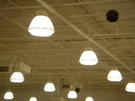 Next time you’re at a night game or in a big box store, look up—if you see bright white lights housed in dome-shaped fixtures, you’re probably looking at metal halide lights. Strong [PDF] new energy efficiency standards for metal halide lamp fixtures proposed yesterday by the U.S. Department of Energy (DOE) would save businesses and consumers money, and would be a step toward meeting President Obama’s goal of reducing carbon dioxide (CO2) greenhouse gas emissions by 3 billion metric tons by 2030 through efficiency standards.
Next time you’re at a night game or in a big box store, look up—if you see bright white lights housed in dome-shaped fixtures, you’re probably looking at metal halide lights. Strong [PDF] new energy efficiency standards for metal halide lamp fixtures proposed yesterday by the U.S. Department of Energy (DOE) would save businesses and consumers money, and would be a step toward meeting President Obama’s goal of reducing carbon dioxide (CO2) greenhouse gas emissions by 3 billion metric tons by 2030 through efficiency standards.
DOE estimates that the new standards would yield $3 billion in net savings for businesses and towns and would reduce CO2 emissions by 15–17 million metric tons by 2030. In addition to big box stores, sports fields, and gymnasiums, metal halide lighting is used in a wide variety of applications including warehouses, parking garages, and streets and roadways. The proposed standards would cover metal halide fixtures from 50–2,000 watts.
 The new efficiency standards would improve the efficiency of the ballasts that are used to drive metal halide lamps. Metal halide lamps need ballasts to start the lamp, regulate the current provided to the lamp, and ensure consistent light output. However, ballasts are not 100% efficient—there are always energy losses between the power input to the ballast and the power output to the lamp. This energy loss is wasted energy since it’s not being converted to light, and the losses can be very large—on the order of 10–30% depending on the wattage of the lamp.
The new efficiency standards would improve the efficiency of the ballasts that are used to drive metal halide lamps. Metal halide lamps need ballasts to start the lamp, regulate the current provided to the lamp, and ensure consistent light output. However, ballasts are not 100% efficient—there are always energy losses between the power input to the ballast and the power output to the lamp. This energy loss is wasted energy since it’s not being converted to light, and the losses can be very large—on the order of 10–30% depending on the wattage of the lamp.
Typical metal halide ballasts are magnetic ballasts, which consist of metal coils wrapped around a magnetic core. The efficiency of magnetic ballasts can be improved by using higher-grade core steel, using copper wiring in place of aluminum wiring, and adding steel laminations. Even bigger efficiency gains can be achieved by switching from magnetic ballasts to electronic ballasts. Instead of using a core and coil, electronic ballasts use electronic circuitry.
The proposed standards for most wattages could be met with improved magnetic ballasts, while the standards for 100–150 watt fixtures would require performance on par with high-efficiency electronic ballasts. The savings from the proposed standard are significant, but we hope before finalizing it DOE will evaluate whether standards based on efficiency levels achievable by electronic ballasts may be appropriate for other wattage levels as well. Under a schedule which DOE sent to New York State’s Attorney General and others last week, the final rule is slated to be released in January.
This proposed standard should be the first of several from DOE this month as the agency works to overcome a backlog of [PDF]overdue standards. By law, a new metal halide lamp fixture standard should have been finalized by January 1, 2012. Protracted delays at the White House’s Office of Management and Budget (OMB) held up this proposed standard as well as pending proposals for commercial refrigerators and walk-in coolers and other standards. However, with President Obama’s renewed commitment to tackling climate change, we are optimistic that the days when a White House office holds up efficiency standards—and the large savings they could deliver—are coming to an end.
Link to February 6, 2013 EIA article: Stadiums and arenas use efficient, high wattage lamps





